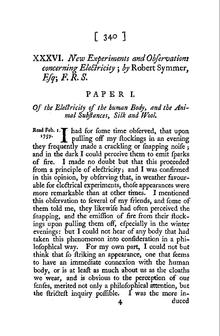Robert Symmer
Robert Symmer FRS (* 1707 ; † 1763 ) was a Scottish philosopher and physicist who was best known for his two- fluid theory of electricity ( fluid hypothesis ).
Life
Symmer's theory
In 1759, Symmer, a Fellow of the Royal Society, published his first and probably only article on his understanding of electricity in Philosophical Transactions of the Royal Society , a journal published by the Royal Society . This treatise, entitled New Experiments and Observations concerning Electricity , appeared there in four parts with the titles
- Of the Electricity of the Human Body and the Animal Substances Silk and Wool (February 1759, pp. 340–347)
- Of the Electricity of Black and White Silk (May 1759, pp. 348-358)
- Of Electrical Cohesion ( Jun 1759, pp. 359-370)
- Of Two Distinct Powers in Electricity (Dec 1759, pp. 371-389).
The main claim made therein was that electricity does not appear as a single force, as the followers of Benjamin Franklin and Giambatista Beccaria believed, but as two equal, separate, antagonistic forces, probably embodied in two different and counterweighted fluids.
The starting point for this theory was his finding that two areas of deficiency repel each other: When he observed two pairs of silk and wool stockings worn on top of one another, Symmer found that the two "negatively" charged stockings also repel each other. The Franklin model did not understand that two deficiency states exert a force on each other. Because of his subsequent habit of rubbing worn socks on objects, he was nicknamed "The Barefoot Philosopher".
Although his theory was ignored in England, his view received approval abroad: in the mid- 18th century , most electricity researchers were Jean-Antoine Nollet , Franz Ulrich Theodor Aepinus , Johan Carl Wilcke , Anton Brugmans (1732–1789) or Torbern Olof Bergman in Europe adherents of the theory of dualistic electricity that Symmer as a restorer, or even as an inventor, the two-fluid theory ( two-fluid theory under consideration). His theory was seen by others as a revival of the theory of Charles du Fay , who in 1733 started from two types of electricity and referred to them as glass electricity ( électricité vitreuse ) and resin electricity ( électricité résineuse ).
Criticism of Symmer's theory
Modern historians of science are sometimes very critical of Symmer's importance. In his book Franklin and Newton: An Inquiry into Speculative Newtonian Experimental Science and Franklin's Work in Electricity as an Example thereof (1956), the science historian I. Bernard Cohen , one of Franklin's most respected connoisseurs of the time, expresses a lack of understanding that Symmer's restoration experiments receive any attention found. In some physics textbooks, however, the dualistic fluid theory is only linked with the name Symmer.
One reason for the negative view of Symmer's importance is that most of the reports on electricity in the 18th century stem from Joseph Priestley's The History and Present State of Electricity (1767), which treated the dualistic position fairly but gave no opportunity to Mocking Symmer left out. However, Mathurin-Jacques Brisson in particular contributed to the observance of Symmer's theory through his imprecise French translation of Priestley and the discrepancy it contained between the derisive treatment of Symmer in the English original and his milder representation in the French Histoire de l'électricité .
Web links and sources
- JL Heilbron: Robert Symmer and the Two Electricities , in: ISIS, 1976, p. 7 ff.
- JL Heilbron: Elements of early modern physics , 1982, ISBN 0520045556, pp. 208, 270, 277
- Histoire de l'électricité et de la physique
- New Experiments and Observations concerning Electricity (Wikimedia Commons)
Individual evidence
- ↑ Andreas von Baumgartner: The theory of nature according to its present state, with consideration for mathematical reasons , Vienna 1836, p. 549
- ↑ Peter Kasten: Pretty charged - Lichtenberg and electricity (PDF; 1.7 MB)
- ↑ SOME NATURAL PHENOMENA and Basics of Electricity and Magnetism: A Story of Symmer`s Stockings
- ↑ Steven H. Voldman: ESD: physics and devices , 2004, ISBN 0470847530, p. 3
- ↑ Popular Science Dec. 1899 , p. 250
- ↑ Chris Smith: How do Thunderstorms Work? The Science of Thunder and Lightning (The Naked Scientists: Science Radio & Science Podcasts)
- ↑ 1758 The socks of the philosopher , in: Reto U. Schneider, Das Buch der Verrückten Expere , 2006, ISBN 3-442-15393-X, pp. 19-21 (PDF; 248 kB)
- ↑ Patricia Fara: An Entertainment for Angels: Electricity in the Enlightenment (book review in sehepunkte.de, 2002)
- ^ Robert D. Purrington: Physics in the nineteenth century , 1997, ISBN 0813524423, p. 34
- ↑ Encyclopédie Universalis
- ↑ Ludwig Bergmann, Clemens Schaefer: Electricity . Walter de Gruyter, January 1, 1966, ISBN 978-3-11-144188-7 , p. 6.
| personal data | |
|---|---|
| SURNAME | Symmer, Robert |
| BRIEF DESCRIPTION | Scottish physicist |
| DATE OF BIRTH | 1707 |
| DATE OF DEATH | 1763 |
